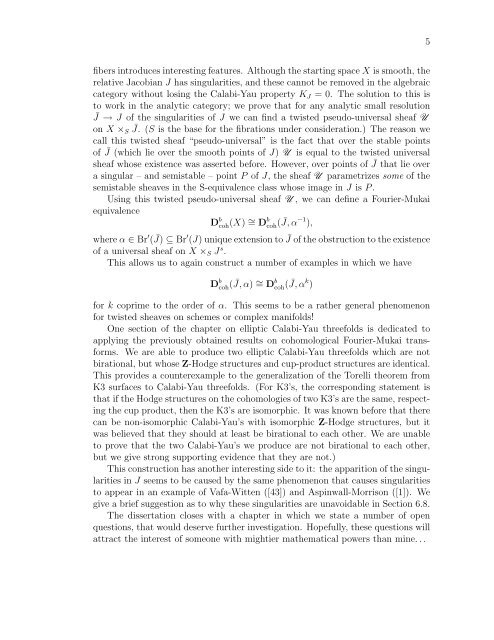derived categories of twisted sheaves on calabi-yau manifolds
derived categories of twisted sheaves on calabi-yau manifolds
derived categories of twisted sheaves on calabi-yau manifolds
Create successful ePaper yourself
Turn your PDF publications into a flip-book with our unique Google optimized e-Paper software.
fibers introduces interesting features. Although the starting space X is smooth, the<br />
relative Jacobian J has singularities, and these cannot be removed in the algebraic<br />
category without losing the Calabi-Yau property KJ = 0. The soluti<strong>on</strong> to this is<br />
to work in the analytic category; we prove that for any analytic small resoluti<strong>on</strong><br />
¯J → J <str<strong>on</strong>g>of</str<strong>on</strong>g> the singularities <str<strong>on</strong>g>of</str<strong>on</strong>g> J we can find a <str<strong>on</strong>g>twisted</str<strong>on</strong>g> pseudo-universal sheaf U<br />
<strong>on</strong> X ×S ¯ J. (S is the base for the fibrati<strong>on</strong>s under c<strong>on</strong>siderati<strong>on</strong>.) The reas<strong>on</strong> we<br />
call this <str<strong>on</strong>g>twisted</str<strong>on</strong>g> sheaf “pseudo-universal” is the fact that over the stable points<br />
<str<strong>on</strong>g>of</str<strong>on</strong>g> ¯ J (which lie over the smooth points <str<strong>on</strong>g>of</str<strong>on</strong>g> J) U is equal to the <str<strong>on</strong>g>twisted</str<strong>on</strong>g> universal<br />
sheaf whose existence was asserted before. However, over points <str<strong>on</strong>g>of</str<strong>on</strong>g> ¯ J that lie over<br />
a singular – and semistable – point P <str<strong>on</strong>g>of</str<strong>on</strong>g> J, the sheaf U parametrizes some <str<strong>on</strong>g>of</str<strong>on</strong>g> the<br />
semistable <str<strong>on</strong>g>sheaves</str<strong>on</strong>g> in the S-equivalence class whose image in J is P .<br />
Using this <str<strong>on</strong>g>twisted</str<strong>on</strong>g> pseudo-universal sheaf U , we can define a Fourier-Mukai<br />
equivalence<br />
D b coh(X) ∼ = D b coh( ¯ J, α −1 ),<br />
where α ∈ Br ′ ( ¯ J) ⊆ Br ′ (J) unique extensi<strong>on</strong> to ¯ J <str<strong>on</strong>g>of</str<strong>on</strong>g> the obstructi<strong>on</strong> to the existence<br />
<str<strong>on</strong>g>of</str<strong>on</strong>g> a universal sheaf <strong>on</strong> X ×S J s .<br />
This allows us to again c<strong>on</strong>struct a number <str<strong>on</strong>g>of</str<strong>on</strong>g> examples in which we have<br />
D b coh( ¯ J, α) ∼ = D b coh( ¯ J, α k )<br />
for k coprime to the order <str<strong>on</strong>g>of</str<strong>on</strong>g> α. This seems to be a rather general phenomen<strong>on</strong><br />
for <str<strong>on</strong>g>twisted</str<strong>on</strong>g> <str<strong>on</strong>g>sheaves</str<strong>on</strong>g> <strong>on</strong> schemes or complex <strong>manifolds</strong>!<br />
One secti<strong>on</strong> <str<strong>on</strong>g>of</str<strong>on</strong>g> the chapter <strong>on</strong> elliptic Calabi-Yau threefolds is dedicated to<br />
applying the previously obtained results <strong>on</strong> cohomological Fourier-Mukai transforms.<br />
We are able to produce two elliptic Calabi-Yau threefolds which are not<br />
birati<strong>on</strong>al, but whose Z-Hodge structures and cup-product structures are identical.<br />
This provides a counterexample to the generalizati<strong>on</strong> <str<strong>on</strong>g>of</str<strong>on</strong>g> the Torelli theorem from<br />
K3 surfaces to Calabi-Yau threefolds. (For K3’s, the corresp<strong>on</strong>ding statement is<br />
that if the Hodge structures <strong>on</strong> the cohomologies <str<strong>on</strong>g>of</str<strong>on</strong>g> two K3’s are the same, respecting<br />
the cup product, then the K3’s are isomorphic. It was known before that there<br />
can be n<strong>on</strong>-isomorphic Calabi-Yau’s with isomorphic Z-Hodge structures, but it<br />
was believed that they should at least be birati<strong>on</strong>al to each other. We are unable<br />
to prove that the two Calabi-Yau’s we produce are not birati<strong>on</strong>al to each other,<br />
but we give str<strong>on</strong>g supporting evidence that they are not.)<br />
This c<strong>on</strong>structi<strong>on</strong> has another interesting side to it: the appariti<strong>on</strong> <str<strong>on</strong>g>of</str<strong>on</strong>g> the singularities<br />
in J seems to be caused by the same phenomen<strong>on</strong> that causes singularities<br />
to appear in an example <str<strong>on</strong>g>of</str<strong>on</strong>g> Vafa-Witten ([43]) and Aspinwall-Morris<strong>on</strong> ([1]). We<br />
give a brief suggesti<strong>on</strong> as to why these singularities are unavoidable in Secti<strong>on</strong> 6.8.<br />
The dissertati<strong>on</strong> closes with a chapter in which we state a number <str<strong>on</strong>g>of</str<strong>on</strong>g> open<br />
questi<strong>on</strong>s, that would deserve further investigati<strong>on</strong>. Hopefully, these questi<strong>on</strong>s will<br />
attract the interest <str<strong>on</strong>g>of</str<strong>on</strong>g> some<strong>on</strong>e with mightier mathematical powers than mine. . .<br />
5
















